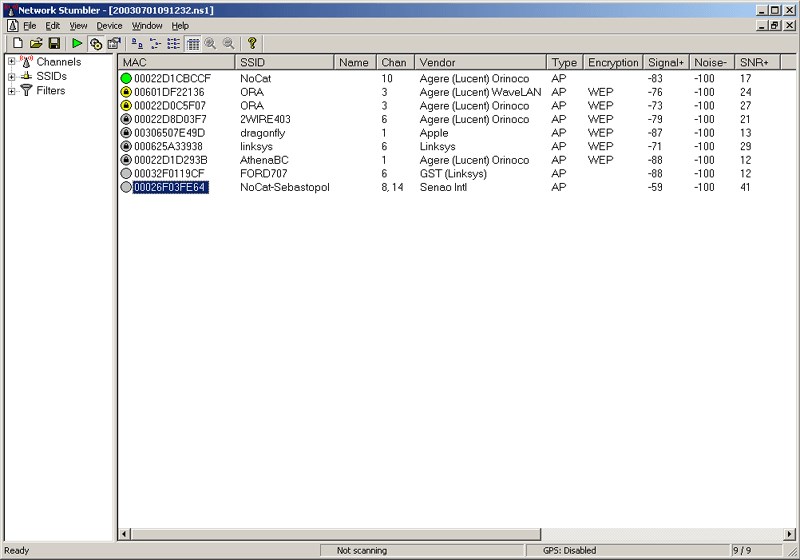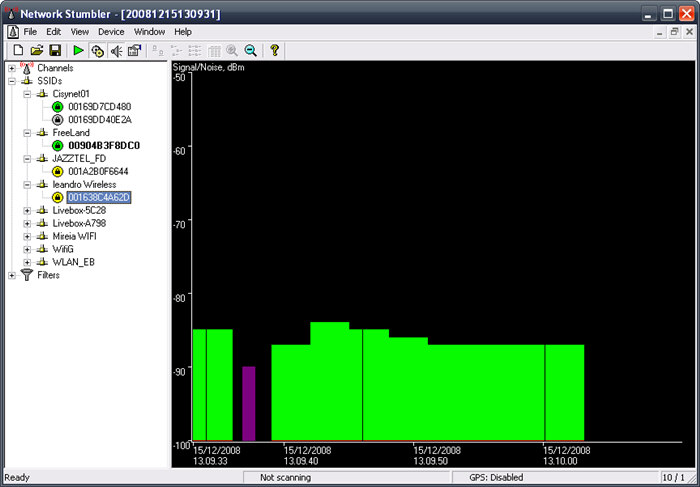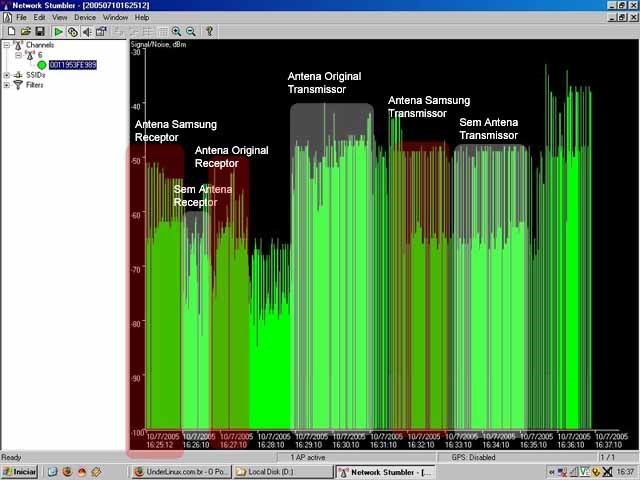A Plea.
Deanna and I (Your Older Geeks) have been running OlderGeeks.com since 2008 and lately we are seeing a major increase in usage (and cost) but a big decline in percentage of users who donate. Our ad-free and junkware-free download site only works if everyone chips in to offset the revenue that ads on other sites bring in.
Please donate on the website today. Every little bit helps.
Thank you so much.
-D&R
Always scroll to the bottom of the page for the main download link.
We don't believe in fake/misleading download buttons and tricks. The link is always in the same place.
NetStumbler v0.4.0
NetStumbler is a tool for Windows that allows you to detect Wireless Local Area Networks (WLANs) using 802.11b, 802.11a and 802.11g. It has many uses:
Verify that your network is set up the way you intended.
Find locations with poor coverage in your WLAN.
Detect other networks that might be causing interference with your network.
Detect unauthorized "rogue" access points in your workplace.
Help aim directional antennas for long-haul WLAN links.
Use it recreationally for WarDriving.
Requirements
General Requirements
The requirements for NetStumbler are somewhat complex and depend on hardware, firmware versions, driver versions and operating system. The best way to see if it works on your system is to try it.
Some configurations have been extensively tested and are known to work. These are detailed at http://www.stumbler.net/compat. If your configuration works but is not listed, or is listed but does not work, please follow the instructions on the web site.
The following are rules of thumb that you can follow in case you cannot reach the web site for some reason.
This version of NetStumbler requires Windows 2000, Windows XP, or better.
The Proxim models 8410-WD and 8420-WD are known to work. The 8410-WD has also been sold as the Dell TrueMobile 1150, Compaq WL110, Avaya Wireless 802.11b PC Card, and others.
Most cards based on the Intersil Prism/Prism2 chip set also work.
Most 802.11b, 802.11a and 802.11g wireless LAN adapters should work on Windows XP. Some may work on Windows 2000 too. Many of them report inaccurate Signal strength, and if using the "NDIS 5.1" card access method then Noise level will not be reported. This includes cards based on Atheros, Atmel, Broadcom, Cisco and Centrino chip sets.
I cannot help you figure out what chip set is in any given card.
Firmware Requirements
If you have an old WaveLAN/IEEE card then please note that the WaveLAN firmware (version 4.X and below) does not work with NetStumbler. If your card has this version, you are advised to upgrade to the latest version available from Proxim's web site. This will also ensure compatibility with the 802.11b standard.
Other Requirements and Compatibility Issues
Your card must be configured in such a way that it can be seen by the management software that came with the card.
The Microsoft-provided Orinoco drivers that come with Windows 2000 do not work with NetStumbler. Please visit Windows Update or www.proxim.com and upgrade to the latest drivers.
When NetStumbler is in "auto reconfigure" mode (the default), it will occasionally disconnect you from your network. This enables it to perform its scans accurately, and is not a bug.
If you have the WLAN card configured to connect to a specific SSID, NetStumbler may not report any accees points other than those that have that SSID. Configure your card with a blank SSID or, if a blank one is not permitted, "ANY" (without quotes).
Legal note
I am not a lawyer. However as a user of this software, you need to be aware of the following.
In most places, it is illegal to use a network without permission from the owner. The definition of "use" is not entirely clear, but it definitely includes using someone else's internet connection or gathering information about what is on the network. It may include getting an IP address via DHCP. It may even include associating with the network.
The IP address reporting functionality in NetStumbler is for you to check the settings of your own network, and for corporate users to identify rogue access points operating within their organization. If you are doing neither of these things, it is suggested that you disable TCP/IP on your wireless adapter. This will help you to avoid possible legal trouble.
Marius Milner, netstumbler.com and stumbler.net accepts no liability for damages caused by use of this software. For further information please consult the License Agreement that can be found both in the installer and in the online help.
Mini-FAQ
Q1. NetStumbler reports "No wireless card found". Why?
A1. Please check the compatibility lists above. Perhaps your adapter is not supported.
Q2. Why doesn't NetStumbler see the access point right next to my machine?
A2A. The access point is configured not to respond to broadcast probes. Most manufacturers call this "disable broadcast SSID" or "closed". NetStumbler cannot see these networks unless you know the SSID and have your machine configured to connect to it.
A2B. Your wireless card is configured to connect to a specific SSID. Try setting it to connect to a blank SSID or to "ANY" (without quotes).
Q3. What 802.11 frames does NetStumbler send?
A3A. It sends out a probe request about once a second, and reports the responses. This is known as Active Scanning.
A3B. (ORiNOCO only and with "Query APs for names" enabled) When it is connected to a BSS network, it will attempt to get the name of the access point. When it is connected to an IBSS network, it will try to get the names of all locally visible peers. This is done via Proxim's proprietary WMP protocol.
A3C. (Only when connected to a Cisco access point and with "Query APs for names" enabled and with a valid IP address ) It will attempt to use Cisco's IAPP protocol to get the name and IP address of the access point.
A3D. If you leave TCP/IP enabled, your adapter may attempt to get a DHCP lease or send other traffic. NetStumbler will record the fact that you were issued an IP address.
Q4. Does NetStumbler listen for beacons, or put my card into promiscuous or RFMON mode?
A4. This is called Passive Scanning and is not in this version.
Q5. I'm seeing access points appear briefly and then disappear for a long time. What's happening?
A5A. Some wireless networks can be configured not to respond to probes every time they hear a request.
A5B. If you see lots of networks that appear briefly and then disappear forever, you may have found a FakeAP installation.
Q6. Why does NetStumbler disconnect me from the network?
A6. If you have "Options->Reconfigure card automatically" checked, it will configure your card with a profile that uses a null SSID and BSS mode (It will not change your WEP settings). Also, when it sees another network that has a better signal than the one you're connected to, it may disconnect the current connection so that it can get the AP name on the other network.
Q7. Does NetStumbler detect ROR and COR installations?
A7. Not usually. They are not always fully compliant with 802.11b and therefore may not be visible to NetStumbler.
Q8. Should I allow Windows XP to manage my wireless settings?
A8. Probably not. When you are not connected to a network, XP will cycle through your favorite network names attempting to connect to them. While this is happening, NetStumbler may not see all available networks. It is recommended that you stop the "Wireless Zero Configuration" service while NetStumbler is running. You can do this by switching on "Auto Reconfigure", from Control Panel, or by running the command "net stop wzcsvc".
Q9. When will you support wireless card X? When will you add new feature Y that I want?
A9. I work on this in my spare time. I can make no commitment to dates for new features or bug fixes. If you would like to help me support a particular piece of hardware, please consider sending me a sample rather than complaining that it isn't supported.
Q10. What does "Auto Reconfigure" actually do?
A10A. When using the ORiNOCO driver, it stops the Wireless Zero Configuration service and makes sure that the card is always set to a blank SSID and BSS mode.
A10B. When using the Prism driver, it stops the Wireless Zero Configuration service and checks for a blank or "ANY" SSID. If necessary, it makes changes to the card's registry settings and prompts you to reinsert the card.
A10C. On all other drivers, it stops the Wireless Zero Configuration service and then does nothing. Usually this is a good thing, but you should experiment with it.



Continue below for the main download link.
|















 , out of 39 Votes.
, out of 39 Votes.
